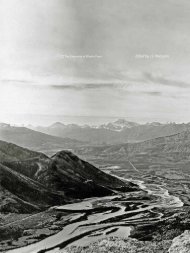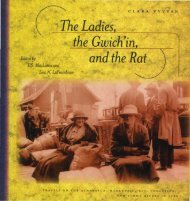Paul Kane's Journal of his Western Travels, 1846-1848 - History and ...
Paul Kane's Journal of his Western Travels, 1846-1848 - History and ...
Paul Kane's Journal of his Western Travels, 1846-1848 - History and ...
You also want an ePaper? Increase the reach of your titles
YUMPU automatically turns print PDFs into web optimized ePapers that Google loves.
silence at The Pas, near which Franklin spent part <strong>of</strong> the<br />
winter <strong>of</strong> 1819-1820 (in fact, at Cumberl<strong>and</strong> House), during<br />
<strong>his</strong> first Arctic expedition, by York boat <strong>and</strong> canoe.<br />
frasher/Frasher /Frashur /Fraser, Colin See Fracher ...<br />
French R. rapids On the most complex section <strong>of</strong> the fur trade<br />
waterways, at the height <strong>of</strong> l<strong>and</strong> between the Lake Superior<br />
<strong>and</strong> Lake Winnipeg watersheds, these rapids seemed to<br />
necessitate a portage on the route along Maligne River (see<br />
River MaIane) between Lac des Mille Lacs (<strong>Kane's</strong> Lake <strong>of</strong><br />
they 1000 Isl<strong>and</strong>s) <strong>and</strong> Pickerel Lake, the latter in presentday<br />
Quetico Provincial Park, on the Ontario/Minnesota<br />
border.<br />
Froshur, <strong>Paul</strong> Joining the North West Company in 1819, <strong>Paul</strong><br />
Fraser (1797 -1855) was made an HBC Chief Trader in 1844.<br />
When Kane met him in <strong>1848</strong>, he had the charge <strong>of</strong> the district<br />
<strong>of</strong> Thompson River (west <strong>of</strong> the upper Columbia River <strong>and</strong><br />
east <strong>of</strong> the Fraser River), <strong>and</strong> likely was en route to York<br />
Factory with the annual brigade <strong>of</strong> furs. Governor Simpson's<br />
"Character Book" entry for him is brief <strong>and</strong> indifferent<br />
(208).<br />
Frot Asneboin Fort Assiniboine (est. 1824 as Athabasca River<br />
House) was visited by Kane October 10, <strong>1846</strong>, <strong>and</strong> November<br />
29 to December I, 1847. T<strong>his</strong> post was located on the<br />
Athabasca River, at its nearest point (about 110 miles) to the<br />
North Saskatchewan River, at the confluence <strong>of</strong> the Athabasca<br />
<strong>and</strong> Freeman Creek. The trail from t<strong>his</strong> post to Fort Edmonton<br />
fonned part <strong>of</strong> the principal transcontinental transportation<br />
route <strong>of</strong> the HBC.<br />
garden Isl<strong>and</strong> In American territory, Garden Isl<strong>and</strong> lies in<br />
Lake <strong>of</strong> the Woods between Big Isl<strong>and</strong>, Ontario (to the east),<br />
<strong>and</strong> Northwest Angle State Forest (to the west), the stretch <strong>of</strong><br />
the lake's western shore that belongs to the state <strong>of</strong> Minnesota.<br />
Its name derives from its being farmed, probably by<br />
Saulteaux.<br />
Garey See Fort Garey.<br />
gMpers/G-..ers/';-pers/';-pers House Jasper House (est.<br />
1799; moved 1811) was visited by Kane November 3-4,<br />
<strong>1846</strong>, <strong>and</strong> November 6-14, 1847. Jasper Hawes was in charge<br />
<strong>of</strong> the North West Company post on Brule Lake (a<br />
widening <strong>of</strong> Athabasca River) in 1814. The site <strong>of</strong> the fort<br />
was always downriver (east) <strong>of</strong> the site <strong>of</strong> the modem town<br />
that retains <strong>his</strong> name, located in Jasper National Park, in<br />
western Alberta. The fort's purpose was always that <strong>of</strong> a<br />
station where boats were changed for horses by westbound<br />
brigades about to cross Athabasca Pass, <strong>and</strong> vice versa for<br />
brigades headed to Fort Edmonton.<br />
Gentalmans wife See Haritt/Harett/H., Mr.<br />
the Govemer See Simson, Sir George.<br />
gr<strong>and</strong> bature [Columbia River] T<strong>his</strong> was a regular gravel bar<br />
on the upper Columbia River, upriver <strong>of</strong> Upper <strong>and</strong> Lower<br />
Arrow lakes, near the present-day town <strong>of</strong> Revelstoke,<br />
British Columbia.<br />
gr<strong>and</strong> bature / Gr<strong>and</strong> Bature [Whirlpool River, east <strong>of</strong> Committee<br />
Punch Bowl] Gr<strong>and</strong> Batture on the Whirlpool River<br />
(whose valley the east side <strong>of</strong> the Athabasca Pass trail fol-<br />
The American Art <strong>Journal</strong>/Volume XXI • Number 2<br />
lowed) dominated the river at one point. Battures, the braided<br />
gravel bars that frequently appear on mountain-fed rivers,<br />
regularly divert t<strong>his</strong> river as it descends from the height <strong>of</strong><br />
l<strong>and</strong>.<br />
Gr<strong>and</strong> bature [Wood River, near Boat Encampment] Like the<br />
Whirlpool River to the east <strong>of</strong> the Athabasca Pass, the Wood<br />
River to the west was dominated by a series <strong>of</strong> braided gravel<br />
bars.<br />
Gr<strong>and</strong> Bonet Like the fall <strong>of</strong> the Pransin Horses or silver fall,<br />
t<strong>his</strong> portage on the lower Winnipeg River, <strong>and</strong> the first <strong>and</strong><br />
second Bonet, are today submerged under the waters dammed<br />
by hydroelectric projects.<br />
Gr<strong>and</strong> Coat See grond coat or big hill.<br />
Gr<strong>and</strong> Colay/Gr<strong>and</strong> Coliee/Coulay The Gr<strong>and</strong> Coulee,<br />
northwest <strong>and</strong> downstream <strong>of</strong> Spokane, Washington, was a<br />
fonner route <strong>of</strong> the Columbia River, but ages before the fur<br />
trade era, the riverbed had fallen well below the floor <strong>of</strong> the<br />
coulee, leaving it dry. Occupied today by a lake, a reservoir<br />
behind Gr<strong>and</strong> Coulee Dam (constr. 1942), in 1847 the coulee<br />
exposed<br />
to view the bases <strong>of</strong> the enormous rocky isl<strong>and</strong>s that now<br />
stud its bottom, some <strong>of</strong> them rising to the elevation <strong>of</strong> the<br />
surrounding country.<br />
T<strong>his</strong> wonderful gully is about 150 miles long, <strong>and</strong><br />
walled-in in many places with an unbroken length twenty<br />
miles long <strong>of</strong> perpendicular basalt 1000 feet high. The<br />
bottom <strong>of</strong> t<strong>his</strong> valley is perfectly level, <strong>and</strong> covered with<br />
luxuriant grass, except where broken by the immense rocks<br />
above mentioned: there is not a single tree to be seen<br />
throughout its whole extent, <strong>and</strong> scarcely a bush; neither<br />
did we see any insects, reptiles, or animals. (WA [209])<br />
Gr<strong>and</strong> daDs<br />
Part <strong>of</strong>, see the DaDs.<br />
Gr<strong>and</strong> Decharge The Gr<strong>and</strong> Decharge was a portage <strong>of</strong> 300<br />
paces. It marked the first carrying place on the Winnipeg<br />
River for the downriver traveler, thirty-three miles north <strong>of</strong><br />
Lake <strong>of</strong> the Woods on the upper section <strong>of</strong> the river. Here<br />
canoes were shot downstream or lined upstream, while their<br />
contents were portaged; hence, discharge is a more accurate<br />
name than portage for the work necessarily performed.<br />
T<strong>his</strong> carrying place was the first <strong>of</strong> five in a five-mile<br />
stretch <strong>of</strong> river. The others' traditional names are: Terre<br />
Jaune, Charette, Terre Blanche, <strong>and</strong> La Cave. Kane refers to<br />
the first <strong>of</strong> these as Yallo Mud (where there is yellow rock).<br />
The second he does not mention; the third he calls White Mud<br />
(where white clay protrudes); <strong>and</strong> the fourth Gr<strong>and</strong> de Equear<br />
or Gr<strong>and</strong> de Equsar. These last names seem to refer to Gr<strong>and</strong><br />
Equierre, the name <strong>of</strong> a fur trade post no longer in use in<br />
<strong>Kane's</strong> day. T<strong>his</strong> post, however, was located downriver, not<br />
upriver, <strong>of</strong> Lac du Bonnet.<br />
Gr<strong>and</strong> de Equear / Gr<strong>and</strong> de Equsar See Gr<strong>and</strong> Decharge.<br />
Gr<strong>and</strong> GuUete T<strong>his</strong> was not a common name for any <strong>of</strong> the<br />
portages, rapids, or falls on the Winnipeg River, but, given<br />
its location in <strong>Kane's</strong> journal, seems to be one <strong>of</strong> the seven<br />
portages on the Blanche River (see River Naloin), a whitewater<br />
channel <strong>of</strong> the Winnipeg River, full <strong>of</strong> what Kane<br />
called "beautiful cas caides" on June 10, <strong>1846</strong>, eight miles<br />
below Gr<strong>and</strong> Rapid <strong>and</strong> above Lac du Bonnet. Seven Sisters<br />
73
















